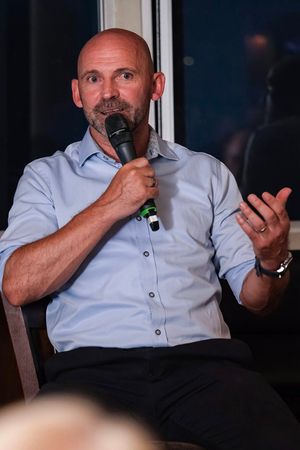“I don’t think you’re gonna need to ask many questions.”
Colin Cameron wasn’t wrong.
When footballers are reunited, dressing room alliances rekindled, it doesn’t matter how many years it has been. Very quickly, it’s like they have never been apart.
Especially when they shared such a dramatic spell together, as it was with Wolves in the early 2000s.
A tumultuous time in many respects, ending with a successful piece of history forever etched into the Molineux folklore.
And Cameron, Alex Rae, Mark Kennedy and Matt Murray? Well, they were all a very hefty part of it.
The conversation, before Murray hosts a Q&A with his former team-mates on another special night of nostalgic fun at the Cleveland Arms, is unrelenting.
Remembering games, team-mates, training ground incidents, tunnel rumbles. Catching up on what they are doing now, what they have heard from others. Even a couple of decades on from when they were occupying the same dressing room at Molineux, or in the portacabins at Compton, it feels like only yesterday.
And, with transfer windows always a hot topic of discussion at this time of year, check out the incomings at Wolves in the summer of 2001.
Kennedy (July), Cameron (August) and Rae (September) were joined by Shaun Newton (August) and Nathan Blake (September). Paul Butler was already there, Kenny Miller followed soon after. With Paul Ince and Denis Irwin the following summer. A formidable group. And one which, eventually, brought promotion.
“The thing with Dave (Jones), he brought in a lot of players who had already been there and done it,” says Cameron.
“Players who had won things, who were captains and leaders, so that once we went and crossed that white line, we could sort everything out ourselves.
“It was a strong dressing room, but I think with any football teams that are successful, you have that element of competition.
“I came to Wolves when I was 27, and if I’d arrived at 21, I wouldn’t have lasted six months.
“I just didn’t have the physicality at that time, I wasn’t ready, but those few years later I was ready, and it was the right time to test myself.”
That dressing room was certainly no place for the faint-hearted. Packed with character and personality, at times that would spill over. But on the pitch? They were very much together.
“I actually think we were quite cliquey as a dressing room,” says Kennedy.

Colin Cameron travelled down from Scotland to meet fans (Martin Hodgkiss Photography)
“I was part of that, as one of the four (Irwin, Butler and Michael Oakes) who used to travel in together from Manchester.
“We were actually quite institutionalised in that group!
“And yet, whenever we went on the pitch, we were absolutely together.
“At the start of a game, I would look around and think, ‘you’re going to have to be really good to beat us today’.
“I always remember that training was the same, every single day - warm-up, crossing and shooting, possession and small-sided game.
“Terry Connor was great and would work with the younger players but we didn’t do anything else, until we went into the Premier League and were getting beat and so Stuart Gray was brought in.
“But other than that, it was all simplified, the gaffer set us up and then when we crossed the white line, it was all down to us.”
Amid so many strong personalities, Murray was one of the young professionals, joining Lee Naylor and Joleon Lescott as the three fresh-faced band of brothers in the play-off winning team of 2003.
His experience of that time is, therefore, slightly different.
“As a young lad at the time I didn’t notice any real cliques,” he explains.
“But for myself and Nayls and Joleon, it was all about learning from these experienced players who had come into the dressing room.
“It was so different to when I played under Mick McCarthy later on, when we had so many younger players and it needed a lot more coaching and tactical work.